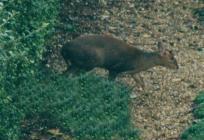
The Muntjac deer has been seen twice on site now
and readers would perhaps be interested to know more about this
secretive little creature.
It is not native to the British Isles - the present, growing
population is descended from escapees from Woburn Estate, early
this century.
In appearance they are surprisingly small, about 18 to 19 inches
at the shoulder, russet in colour, and present a distinctly
rounded outline at the spine. Their faces are different from any
other wild deer and are very distinctive, the buck especially so.
He has a V-shaped ridge on his forehead, leading up to furry
protusions ending in tiny antlers. He does not use these for
fighting over females, preferring instead his teeth, the canines
of which are long and project over his lower jaw.
The female is hornless. Both sexes have very prominent scent
glands under the inner corner of the eye. When alarmed, the
Muntjac raises its tail to show white underneath.
They are seldom seen, preferring to browse and graze in the deep
cover of either heavy scrub or woodland. Their successful
colonisation of the South of England is partly due to this
secretive behaviour, and partly to the fertility of the species.
A doe may conceive almost immediately after fawning and, with no
fixed rutting season, is capable of producing a fawn every 7 or 8
months, if conditions are favourable.
They are spreading slowly north and westwards and with their
increasing numbers perhaps we will have more sightings of this
delightful and attractive little deer in the future.
